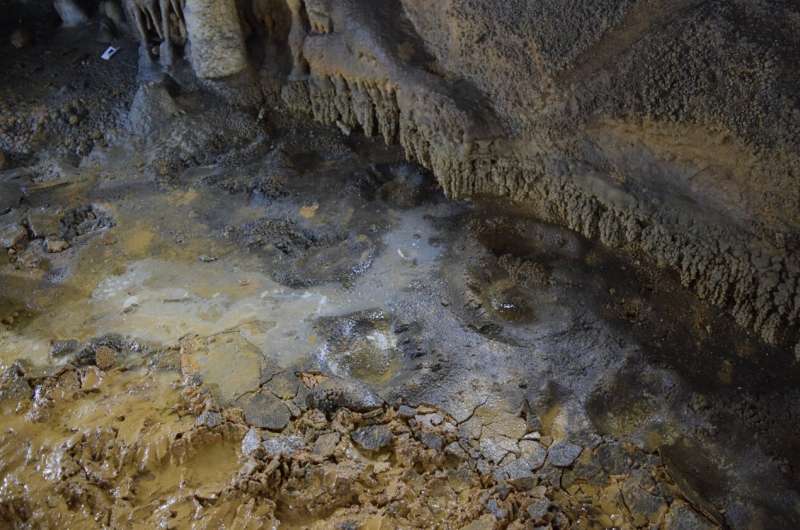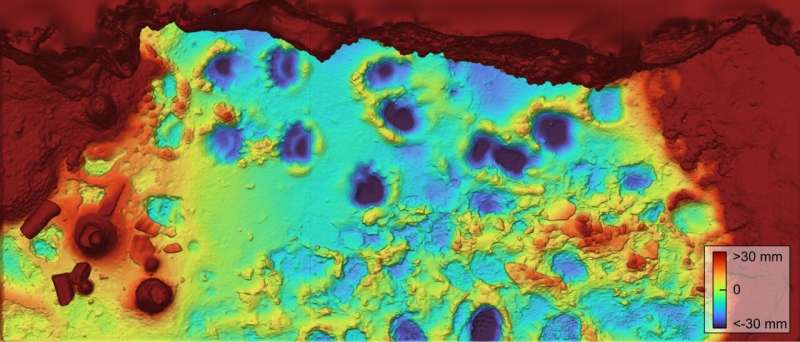This article has been reviewed according to Science X's editorial process and policies. Editors have highlighted the following attributes while ensuring the content's credibility:
fact-checked
peer-reviewed publication
proofread
Fossil footprints study is the first to track cave bears in the Iberian Peninsula

A set of footprints impressed in clay in the Honseca Cave (Velilla del Río Carrión, Palencia), which were made by cave bears that inhabited this area during the Late Pleistocene, are the subject of a new article featured on the cover of the journal Ichnos.
The set, which consists of 16 footprints of the front and hind legs of bears, was discovered by members of the Velilla del Río Carrión Speleological Association, who have also provided logistical support in this study. Jesús Rodríguez, Alfonso Benito, Adrián Martínez and Ana Mateos, scientists at the Centro Nacional de Investigación sobre la Evolución Humana (CENIEH), are the authors of the paper.
Bear tracks are not uncommon in the soft sediments of the caves of the Iberian Peninsula, and many speleologists are familiar with their presence. "However, until now, these fossil traces had not been the subject of systematic research. In fact, to date only one study of this type was carried out in the Urşilor Cave in Romania," says Mateos.
Three-dimensional model
To carry out this study, the team needed to create a three-dimensional model of the footprints. This was achieved by combining two different techniques, laser scanning and photogrammetry, conducted in the CENIEH Digital Mapping and 3D Analysis Laboratory.
As Martinez, a technician at this laboratory, explains, "We carried out a scan of the surface with the footprints and its immediate surroundings with a laser scanner that creates a three-dimensional cloud of millions of points and we combined it with a model obtained by photogrammetry."

This model has been used to take different measurements of the footprints and compare them with those of other caves in Europe, like the Romanian cave of Urşilor. "In addition, processing the model has allowed us to generate images that highlight the shape of each individual footprint," adds Benito.
Ursichnus europaeus
Fossil footprints are not named after the species believed to have made them; instead, they are assigned a Latin name specific to each type of footprint (or ichnotaxon) based on their shape. The analyses conducted on the 3D model indicate that the Honseca footprints are similar to those described in Urşilor Cave and, therefore, should be assigned to the same ichnotaxon, named Ursichnus europaeus.
The shape of the toe impressions and the length of the claw marks, both in Urşilor and Honseca, suggest that in both cases they belong to cave bears, a species that went extinct about 28,000 years ago, rather than brown bears.
"Unfortunately, some of the footprints were destroyed by the footsteps of amateurs who visited the interior of the cave without being careful before the scientists knew of their existence. Therefore, one of the goals of these types of studies is to highlight the value of these fossils and promote their preservation," says Rodríguez, lead author of the work.
More information: J. Rodríguez et al, Cave bear tracks ( Ursichnus europaeus Diedrich, 2011) from Honseca Cave, Palencia, Spain, Ichnos (2025). DOI: 10.1080/10420940.2024.2446153
Journal information: Ichnos
Provided by CENIEH



















